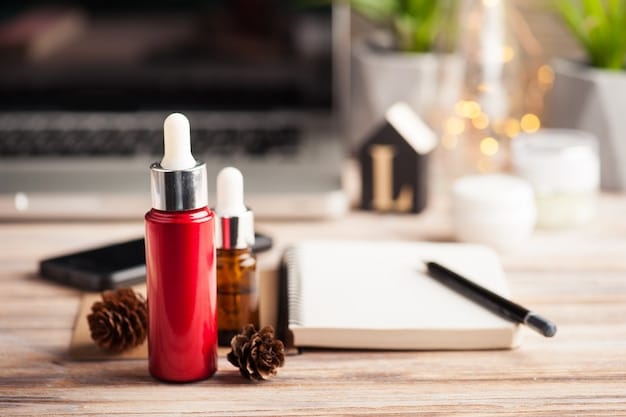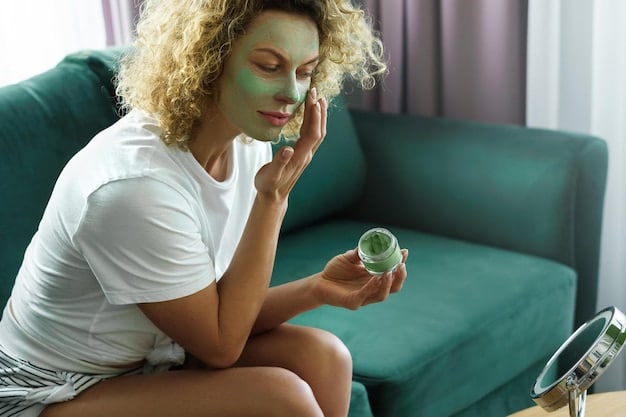Retinol 101: Your Guide to Visible Skin Results in 3 Months

Retinol, a derivative of vitamin A, is a powerful skincare ingredient known for its ability to reduce wrinkles, fight acne, and improve overall skin texture; incorporating it into your routine requires a strategic approach to minimize irritation and maximize effectiveness, with noticeable results typically appearing within three months.
Ready to unlock radiant, youthful skin? This Retinol 101: How to Incorporate It Into Your Skincare Routine for Visible Results in 3 Months guide will help you navigate the world of retinol and achieve your skincare goals safely and effectively.
Understanding Retinol: The Science Behind the Glow
Retinol is a game-changer in the skincare world, but what exactly is it? Derived from vitamin A, retinol is a retinoid that works by speeding up cell turnover and boosting collagen production. This section will break down the science, explaining how retinol can transform your skin.
What is Retinol and How Does It Work?
Retinol belongs to a class of compounds known as retinoids, which are derivatives of vitamin A. When applied to the skin, retinol is converted into retinoic acid, the active form that interacts with skin cells. This interaction signals cells to behave in a more youthful and healthy manner.
Retinol works through several mechanisms including increasing cell turnover, which helps exfoliate the skin, reducing the appearance of fine lines, wrinkles, and acne. It also stimulates collagen production, improving skin elasticity and firmness.
Benefits of Retinol: More Than Just Anti-Aging
While often associated with anti-aging, the benefits of retinol extend far beyond wrinkle reduction. It can improve a variety of skin concerns, making it a versatile addition to almost any skincare routine.
- Reduces Wrinkles and Fine Lines: By stimulating collagen production, retinol helps to plump the skin, diminishing the appearance of fine lines and wrinkles.
- Fights Acne: Retinol’s exfoliating properties help to unclog pores and prevent acne breakouts.
- Improves Skin Texture: Regular use of retinol can result in smoother, more even-toned skin.
- Fades Dark Spots: Retinol can help fade hyperpigmentation, such as sunspots and acne scars, by promoting cell turnover.
In short, retinol is a multi-tasking ingredient that can address various skin issues, leading to a healthier, more radiant complexion.
Understanding the science behind retinol and its numerous benefits sets the stage for effectively incorporating it into your skincare routine. By knowing how it works, you can appreciate the potential results and approach its use with confidence.
Choosing the Right Retinol Product
With so many retinol products on the market, selecting the right one can feel overwhelming. This section will guide you through the factors to consider when choosing a retinol product, ensuring you pick one that suits your skin type and concerns.
Understanding Retinol Strength and Formulations
Retinol products come in various strengths, typically ranging from 0.01% to 1%. Starting with a lower concentration is usually recommended, especially for those new to retinol or with sensitive skin. This approach minimizes the risk of irritation while still delivering noticeable results.
Formulations also vary, including creams, serums, and lotions. Creams are often more hydrating and suitable for dry skin, while serums are lightweight and better for oily or acne-prone skin.
Ingredients to Look For (and Avoid)
When examining the ingredient list, look for complementary ingredients that can enhance retinol’s effects or mitigate potential irritation. Also, be aware of ingredients that may cause adverse reactions when combined with retinol.
- Look For: Hyaluronic acid (for hydration), ceramides (to support the skin barrier), and antioxidants like vitamin C and E (to fight free radicals).
- Avoid: Harsh exfoliants like AHAs/BHAs (to prevent over-exfoliation), and products with high alcohol content (which can dry out the skin).
Product Recommendations Based on Skin Type
Choosing a retinol product tailored to your specific skin type can greatly improve your experience and results. Here are some general recommendations:
- Dry Skin: Opt for retinol creams with added moisturizers and emollients.
- Oily Skin: Choose lightweight retinol serums or gels to avoid clogging pores.
- Sensitive Skin: Look for retinol products specifically formulated for sensitive skin, often with lower concentrations and soothing ingredients.
- Acne-Prone Skin: Retinol serums with ingredients like salicylic acid can help combat breakouts.

Selecting the right retinol product involves considering factors like strength, formulation, and additional ingredients. Tailoring your choice to your skin type and concerns will help ensure a positive experience and optimal results.
Building Your Retinol Routine: Step-by-Step Guide
Incorporating retinol into your skincare routine requires a strategic approach. This step-by-step guide will help you build a routine that maximizes benefits while minimizing potential irritation.
Patch Testing: Why It’s Crucial
Before applying retinol all over your face, it’s essential to perform a patch test. Apply a small amount of the product to a discreet area, such as your inner arm or behind your ear, and wait 24-48 hours to check for any adverse reactions.
The Sandwich Method: Buffering Irritation
The sandwich method involves applying a layer of moisturizer before and after retinol application. This technique helps to buffer the effects of retinol, reducing dryness and irritation, especially for those with sensitive skin.
Frequency of Use: Start Low and Go Slow
When starting retinol, begin with a low frequency of use, such as once or twice a week. Gradually increase the frequency as your skin builds tolerance. Overuse can lead to redness, peeling, and irritation.
Beginning slowly allows your skin to gradually adjust to the retinol, minimizing potential side effects and ensuring a more comfortable experience.
Layering with Other Products: What to Combine and Avoid
Knowing which products to combine with retinol and which to avoid is crucial for a successful skincare routine. Some ingredients can enhance retinol’s effects, while others can lead to irritation or reduced efficacy.
- Combine With: Hyaluronic acid (for hydration), niacinamide (to calm inflammation), and sunscreen (for sun protection).
- Avoid: AHAs/BHAs (to prevent over-exfoliation), benzoyl peroxide (to avoid irritation), and vitamin C (can be used at different times of the day).
Sunscreen is non-negotiable when using retinol, as it increases the skin’s sensitivity to the sun. Apply a broad-spectrum sunscreen with an SPF of 30 or higher every morning.
To sum up, building a retinol routine involves patch testing, the sandwich method, gradual frequency increase, and careful layering. By following these steps, you can safely and effectively integrate retinol into your skincare regimen.
Managing Retinol Side Effects: What to Expect
While retinol offers numerous benefits, some side effects are common, especially when starting out. This section will help you understand what to expect and how to manage these effects effectively.
Common Side Effects: Redness, Peeling, and Dryness
The most common side effects of retinol include redness, peeling, dryness, and increased sensitivity to the sun. These effects are usually temporary and subside as your skin adjusts to the treatment.
Lowering the frequency of use and incorporating hydrating products can help alleviate these symptoms. It’s important to remember that some irritation is normal, but excessive discomfort should be addressed.
Tips for Minimizing Irritation
Several strategies can help minimize irritation when using retinol. These include:
- Use the Sandwich Method: Apply moisturizer before and after retinol.
- Choose the Right Formulation: Opt for creams if you have dry skin and serums if you have oily skin.
- Start with a Low Concentration: Begin with a lower percentage of retinol and gradually increase as tolerated.
When to Seek Professional Advice
While mild irritation is generally manageable, there are situations when seeking professional advice from a dermatologist is necessary. These include:
- Severe Redness or Swelling: Indicates a strong reaction that may require medical intervention.
- Persistent Peeling or Dryness: Suggests that your skin is not tolerating the product and needs adjustment.
- Signs of an Allergic Reaction: Such as hives, itching, or difficulty breathing.

Managing retinol side effects involves understanding what to expect, using strategies to minimize irritation, and knowing when to seek professional advice. With the right approach, you can navigate these challenges and enjoy the benefits of retinol.
Maximizing Retinol Results: Patience and Consistency
Achieving visible results with retinol takes time and commitment. This section will emphasize the importance of patience and consistency, along with other factors that can maximize your outcomes.
The 12-Week Timeline: What to Expect and When
While individual results may vary, most people start to see noticeable improvements in their skin within 12 weeks of consistent retinol use. This timeline allows for cell turnover and collagen production to increase, leading to visible changes in texture and tone.
During the first few weeks, you may experience some initial side effects, such as dryness and peeling. These effects typically subside as your skin adjusts, and by the 12-week mark, you should begin to see more significant improvements.
Tracking Progress: Before and After Photos
Taking before and after photos can be a helpful way to track your progress with retinol. Photos allow you to visually compare your skin’s condition over time, highlighting improvements that may not be immediately apparent.
Ensuring consistent lighting and angles when taking photos will provide a more accurate comparison.
Lifestyle Factors That Enhance Retinol’s Effects
Several lifestyle factors can enhance retinol’s effects. These include:
- Hydration: Drinking plenty of water helps keep your skin hydrated and supports its overall health.
- Healthy Diet: Consuming a balanced diet rich in vitamins and antioxidants can improve skin texture and tone.
- Adequate Sleep: Getting enough sleep allows your skin to repair and regenerate, enhancing the benefits of retinol.
Maximizing retinol results involves patience, consistency, tracking progress, and adopting healthy lifestyle habits. By staying committed to your routine and taking care of your overall health, you can achieve and maintain radiant, youthful skin.
Common Mistakes to Avoid When Using Retinol
Even with the best intentions, it’s easy to make mistakes when using retinol. This section will highlight common pitfalls and how to avoid them, ensuring a successful and effective skincare routine.
Over-Exfoliating: The Importance of Balance
One of the most common mistakes is over-exfoliating the skin, either by using retinol too frequently or combining it with other strong exfoliants like AHAs/BHAs. This can lead to redness, irritation, and a compromised skin barrier.
To avoid over-exfoliation, start with a low frequency of retinol use and gradually increase as tolerated. Also, avoid using other exfoliating products on the same days you use retinol.
Skipping Sunscreen: A Must-Do Every Day
Skipping sunscreen while using retinol is a major mistake. Retinol increases the skin’s sensitivity to the sun, making it more prone to sunburn and sun damage. Daily sunscreen use is non-negotiable.
Apply a broad-spectrum sunscreen with an SPF of 30 or higher every morning, even on cloudy days. Reapply every two hours when exposed to direct sunlight.
Ignoring Skin Sensitivity: Pay Attention to Your Skin
Ignoring signs of skin sensitivity, such as excessive redness, peeling, or irritation, can lead to further problems. Pay attention to how your skin responds to retinol and adjust your routine accordingly.
If you experience significant irritation, reduce the frequency of use or try the sandwich method. If symptoms persist, consult a dermatologist.
Avoiding common mistakes when using retinol involves maintaining balance, using sunscreen daily, and paying attention to your skin’s sensitivity. By being mindful of these pitfalls, you can maximize the benefits of retinol while minimizing potential side effects.
| Key Point | Brief Description |
|---|---|
| ✨ Retinol Benefits | Reduces wrinkles, fights acne, improves skin texture and fades dark spots. |
| 🧴 Choosing Products | Start with low strength, look for hydrating ingredients, and match to your skin type. |
| 📅 Building a Routine | Patch test, use the sandwich method, and gradually increase frequency. |
| ☀️ Sunscreen is Key | Retinol increases sun sensitivity; use SPF 30+ daily for protection. |
Frequently Asked Questions About Retinol
▼
The best time to apply retinol is in the evening, as retinol can make your skin more sensitive to the sun. Applying it at night allows it to work while you sleep, minimizing sun exposure risk.
▼
It depends on your skin’s tolerance. Start with once or twice a week and gradually increase the frequency if your skin doesn’t show signs of irritation like redness, peeling, or dryness.
▼
If your skin becomes irritated, reduce the frequency of retinol use. You can also use the “sandwich method” by applying a moisturizer before and after the retinol to buffer its effects.
▼
While both are beneficial, it’s best to use them at different times of the day. Use vitamin C in the morning for its antioxidant properties and retinol at night to avoid potential irritation.
▼
Most people start to see visible results within 12 weeks of consistent use. Results may include reduced fine lines, improved skin texture, and a more even skin tone with continued use.
Conclusion
Incorporating retinol into your skincare routine can be a transformative journey with patience and consistency. By understanding its benefits, choosing the right product, and managing potential side effects, you can achieve radiant, youthful skin within three months. Start slow, stay consistent, and always protect your skin with sunscreen.





